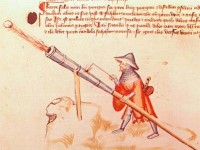The hand tube can be described as the first handgun, which could be worn and used by a man. It is considered a precursor to all subsequent firearms such as rifles and pistols.
The formation was about the same time as the first field guns around the year 1300 rum.
Who has invented the hand tube can not be clarified until today, since no traditions were preserved. Presumably it came via the trade routes from Italy to Central Europe and Flemish mercenaries to England. The first truly dated hand pipes come from the castles Otepää in Estonia from 1396 and Tannenberg from 1399. In Europe, these weapons were used until the early 16th century and gradually replaced by the more sophisticated Arkebuse. In Asia and there especially in China, however, the weapon remained in use until the 19th century.
The structure of the hand tube:
The hand tubes usually had a length of 19 to 60cm, a diameter (caliber) of 12 to 36mm and were initially cast from bronze. With the advent of steel, these were later cast from iron, the caliber in the later models held at 35mm.
Due to the 2-part structure, the gunpowder could be stored in the back of the hand tube, in the front part with the larger caliber the bullet. Depending on the weight, which could vary between 1.5 and 15 kg for heavy siege variants, the weapon was usually clamped like a lance under the arm and fired. The heavy weapons lay on tripods or walls, on the battlefield it was also possible to fire carrying the weapon on his shoulder.
The possible uses:
The hand tubes had a range of about 300m. However, they achieved the greatest effectiveness in melee combat to about 50 to 100m, since the aiming with these weapons was more difficult than comparison with crossbows or bows. Also, the rate of fire with 1 shot per minute was rather low compared to the crossbow 2 rounds per minute and longbow 12 rounds per minute. In addition, the gun was more susceptible to the weather because of the gunpowder.
The advantages of the weapon, however, lay in the low production costs amounted to only the twentieth of a crossbow, the rapid production of 1 day and the rapid training on this weapon. So many soldiers could be set up and deployed within a very short time.
This post is also available in:
 Deutsch (German)
Deutsch (German)  Français (French)
Français (French)  Italiano (Italian)
Italiano (Italian)  简体中文 (Chinese (Simplified))
简体中文 (Chinese (Simplified))  Русский (Russian)
Русский (Russian)  Español (Spanish)
Español (Spanish)  العربية (Arabic)
العربية (Arabic)












